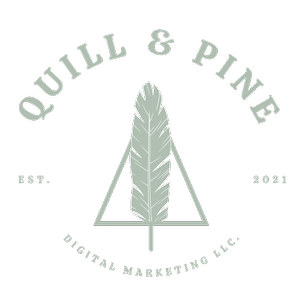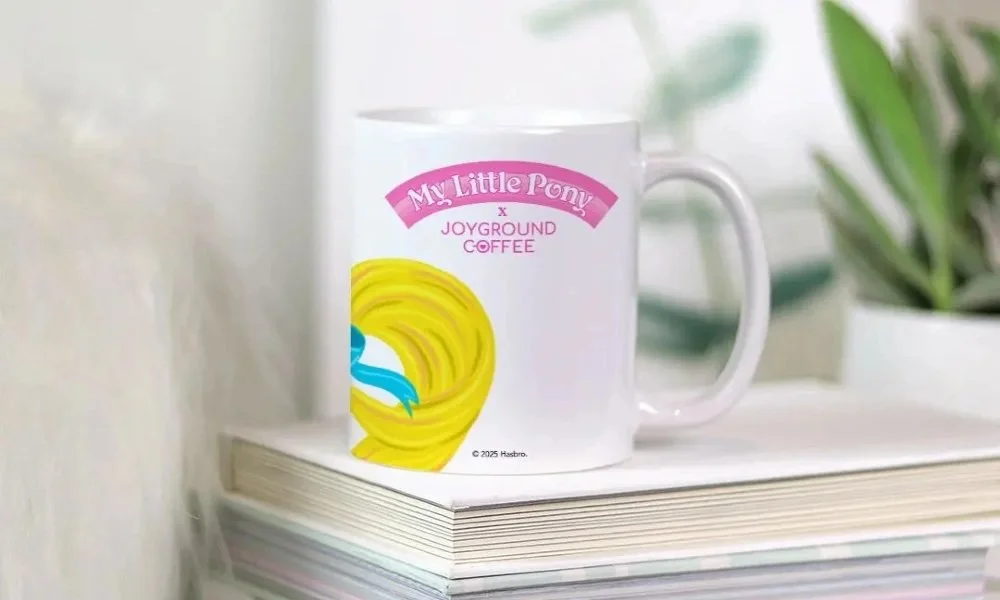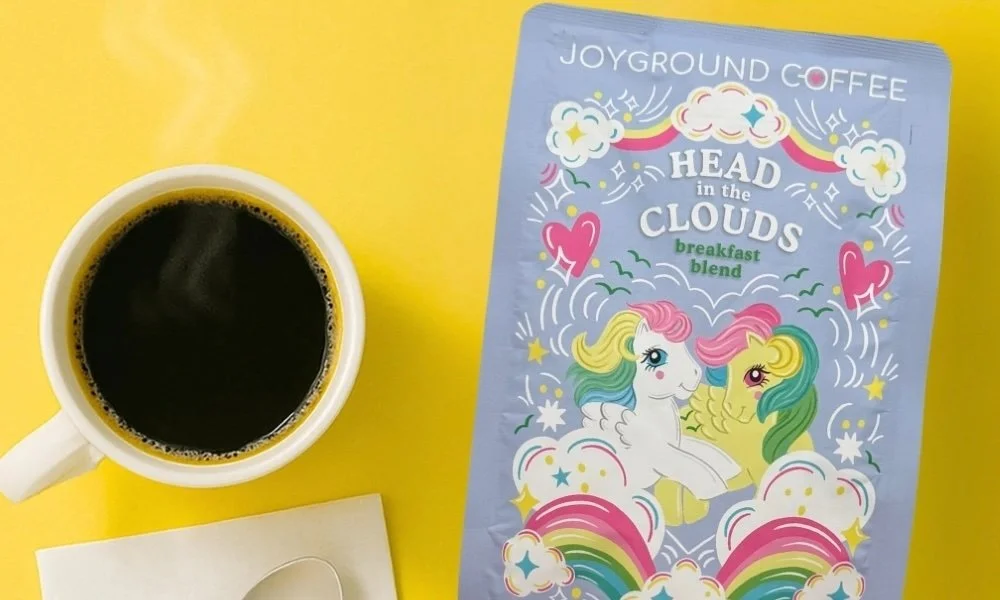MTPak Coffee Article
How effective is branded coffee bag printing?

Originally published on MTPak Coffee’s Education Center.
The specialty coffee market is more competitive than ever, meaning it’s harder for roasters to capture consumers’ attention on crowded shelves. For many, branded coffee bag printing has become an effective way to communicate their identity and make a distinctive first impression.
Some are taking branded coffee packaging a step further by collaborating with well-known franchises to create limited-edition coffee products. This unique approach leverages external brand recognition to help roasters attract new customers and create a novel packaging experience.
To learn more, I spoke to Regina Ross, co-founder and Head of Brand at Joyground Coffee. She shared details on the company’s recent collaboration with My Little Pony, alongside her tips on branded coffee bag printing. Read on for her insight.
The strategy behind branded coffee bag printing
Branded collaborations are a reliable marketing opportunity for specialty coffee roasters. Coffee businesses have long partnered with musicians, celebrities, artists, and well-known franchises to create limited edition co-branded products.
There are various reasons why roasters might want to explore branded coffee bag printing. Primarily, these collaborations help roasters appeal to new consumer bases. By harnessing iconography, designs, or characters associated with an intellectual property (IP), they can tap into their collaborator’s existing audiences.
A recent study showed that people are more likely to purchase and spend more on food and beverage products endorsed by recognisable figures. Therefore, branded coffee bag printing is a viable way to quickly, efficiently expand your roastery’s potential customer base.
Nostalgia has also become a powerful marketing tool for coffee businesses. Collaborating with a franchise or IP that feels familiar to consumers can help spark an emotional connection. This can stimulate interest in the product by capitalising upon existing brand equity.
For Joyground Coffee’s recent collaboration with the popular franchise My Little Pony, Regina says nostalgia played a central role.
“Joyground Coffee’s tagline is ‘Perk up your inner child,’ so we wanted to launch our brand with a well-known IP that would provide a bit of nostalgic escapism for our target consumer,” she explains. “By including an officially licensed collaboration from the start, we knew we would be able to tap into a turnkey fanbase that would distinguish us from other startup coffee brands.”
Before moving forward with a brand partnership, roasters have to answer a number of questions. You should be clear about what you want to achieve and which brands make the most sense for your goals and target audience.
“My co-founder and I have spent our entire careers in the licensing industry,” Regina adds. “We were able to leverage decades of experience and connections to solidify the right partnership.”
Once you’ve determined which IP is most suited to your roastery, you also need to consider legality and logistics. This includes permissions, licensing, trademark rights, and understanding exactly what each party gets from the deal.
“Most licensing deals require a percentage product royalty with a minimum guarantee, an advance payment on that guarantee, and insurance minimums,” Regina explains. “As long as Joyground Coffee was able to meet the licensor’s terms, we found that they were very open to working with us, even though our brand is new.”
What should you include on branded coffee bags?
The design of your branded coffee bags is arguably the most important factor for roasters to consider. After all, the design is what consumers will immediately notice, especially if it’s tied to a familiar IP. Up to 72% of consumers say packaging design influences purchasing decisions, so you need to consider it carefully before coffee bag printing.
Effective branded coffee packaging combines strong visual appeal, functional design, authenticity, and storytelling. Elements such as colour, fonts, and imagery contribute to creating a recognisable identity that your customers will remember. After all, using consistent branding on your packaging can increase brand recall by up to 80%.
The considerations are slightly different when it comes to collaborative packaging, however. Roasters need to find the ideal balance of their third party’s recognisable iconography and their own existing design philosophies.
When working with a licensed property, Regina says that roasters should lean into the collaboration as far as they want. “We’ve chosen to strike a balance between the My Little Pony brand and Joyground Coffee, approaching it like a collaboration,” she explains. “Our goal is that when you see one of our products, you’ll recognise it as Joyground, whether we’ve integrated a licensed property or not.”
When it came to Joyground’s coffee bag printing, choosing the appropriate characters, colours, and design was top priority. “Because we are using a property like My Little Pony that traditionally skews young, it’s crucial that the artwork feels elevated and mature,” she explains. “We hired an illustrator to re-draw the characters using a whimsical, modern folk aesthetic, and Hasbro has been very supportive of us reimagining the franchise in this way.
“They also have guided us to the most popular characters, so we married those fan favourites with top-selling coffee varieties to launch with a lineup of four products,” she adds.
Deciding which text to include on the bags is equally important. Most traditional coffee bags include details about the coffee, such as origin, roast date, processing method, and flavour notes.
However, this works differently for branded coffee bag printing. Alongside recognisable designs, you may want to add unique copy explaining the collaboration. On the other hand, you may also choose to use less text, allowing the visual design to stand out.
“We roast to order, so bean selection and roast date are added by sticker to the bottoms of the packaging,” says Regina. “We knew My Little Pony collectors would want to keep the bags as collectables, so we chose to keep the messaging minimal.”
How sustainable is branded coffee bag printing?
Packaging is responsible for nearly 40% of global plastic waste, which makes sustainability a critical element of branded coffee bag printing. Beyond the environmental aspect, consumers are also increasingly choosing products that use eco-friendly packaging.
The most obvious way roasters can prioritise packaging sustainability is by choosing the right materials. Roasters should look for bags made from recyclable, compostable, or biodegradable materials, such as polylactic acid (PLA), kraft paper, and rice paper. These materials require less energy to manufacture, reduce reliance on fossil fuels, and are easier for customers to dispose of at home.
Roasters should also think about the type of ink used for their coffee bag printing. Traditional inks are often petroleum-based and contain volatile organic compounds (VOCs), which are harmful to the environment and interfere with the recycling process.
Many packaging manufacturers now offer more eco-friendly alternatives, such as soy- and vegetable-based inks, UV-cured inks, and water-based inks. Ultimately, the choice of ink will depend on availability, cost, and print quality.
Therefore, it’s another consideration alongside the design of your coffee bags when working with recognised franchises and IPs. However, sustainability is not always easily achievable for startups.
Given the extensive cost of entry in launching a coffee business, sustainability can present some barriers. It’s something that Regina has observed, too. “At this stage, our focus is on branding opportunities,” she says.
Working with low minimum order quantity (MOQ) packaging suppliers can help coffee startups bypass these issues. It reduces the amount of packaging you have to order in each shipment, meaning less waste and fewer materials required to produce your custom bags.
At MTPak Coffee, we offer low-MOQ coffee packaging with full-scale customisation. Our custom printing services allow us to apply water-based inks to a range of eco-friendly materials, including PLA, kraft, and rice paper. That way, roasters don’t have to choose between standout packaging design and eco-friendliness.
Contact the MTPak Coffee team to learn more about our eco-friendly coffee bag printing solutions.


